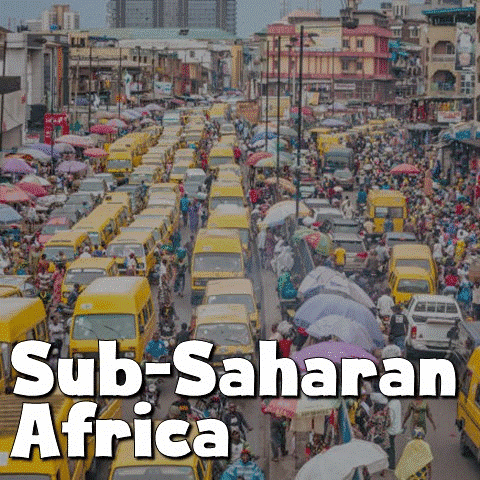Central African Countries and Geography

Central Africa is a region in the heart of the African continent that is known for its rainforests, wildlife, and major rivers like the Congo River. The climate is mostly tropical, with high temperatures and significant rainfall throughout the year. The climate, marked by a distinct wet and dry season, dictates agricultural cycles and the availability of water resources, which can impact food security in the region.
Geography also plays a crucial role in the livelihoods of people in the Central African region. The region's vast rainforests provide resources for subsistence farming, hunting, and gathering, while the fertile soils along rivers support agriculture and fishing. The presence of valuable natural resources, such as minerals and timber, drives economic activities like mining and logging, though these often come with environmental and social challenges. Furthermore, the diverse topography, including mountains, plateaus, and rivers, affects transportation and communication, that influences trade and access to markets.
Cameroon features coastal plains, high plateaus, and the Cameroon Volcanic Line, a chain that extends into the Atlantic Ocean. The country also has rainforests, savannas, and the Lake Chad Basin found in the north. Its varied geography influences its economy, with agriculture, mining, and tourism thriving in different regions. The country's position as a bridge between Central and West Africa also plays a role in trade routes and cultural exchanges.
The Central African Republic (CAR) is landlocked and covered by savannas and dense rainforests, with the Ubangi and Chari rivers forming part of its borders. CAR's location presents challenges for infrastructure development and access to markets. However, the country's natural resources, including timber and minerals, offer economic potential.
Chad has a southern portion of the Sahara Desert in its northern region, semi-arid Sahelian belt in the central region, and fertile savannas in the south. The Lake Chad Basin also forms part of its borders. Agriculture, livestock farming, and oil production are significant sectors of the country's economy. Chad's landlocked status and dependence on Lake Chad for water resources also shape its relations with neighboring countries.
The Democratic Republic of Congo (DRC) is Central Africa's largest country, and has diverse landscapes that include towering mountains like the Rwenzori and Virunga ranges, vast swaths of dense rainforest that sprawl across the land, and open savannas that stretch out in other regions. This terrain plays a crucial role in the DRC's economy. The country holds a treasure trove of natural resources, from minerals and timber to immense hydroelectric potential. These resources fuel economic activity, yet their very abundance presents challenges. Conflicts for control of these riches, coupled with a lack of infrastructure and pressing environmental issues, often create significant roadblocks to development.
The Republic of Congo is dominated by dense rainforests, with the Congo River forming part of its border. The country also has coastal plains along the Atlantic Ocean. Congo's rainforests are rich in biodiversity and natural resources, contributing to its economy through timber, oil, and mineral extraction. Challenges such as deforestation and environmental degradation pose threats to both ecosystems and local communities.

Equatorial Guinea comprises several islands and a mainland region that is dominated by rainforests. The country is located in the Gulf of Guinea, with access to both the Atlantic Ocean and the Gulf of Guinea. Equatorial Guinea's geography contributes to its economy through oil production and fishing industries. Political instability and limited diversification hinder sustainable development and equitable growth.
Gabon is known for its dense rainforests, with coastal plains along the Atlantic Ocean. The country also has significant biodiversity, including national parks and protected areas such as Loango National Park where you can see chimpanzees, gorillas, and even whales.
Its rainforests support industries like logging, ecotourism, and mining. However, concerns about deforestation, wildlife conservation, and sustainable development are increasingly prominent as Gabon becomes more populated and developed.

Sao Tome and Principe is a small island nation in the Gulf of Guinea. It consists of two archipelagos about 150 miles off the coast of Gabon. With about 200,000 people, the country is the second smallest in Africa (only Seychelles is smaller). Its economy is based on agriculture, tourism, and fishing. Sao Tome and Principe's geographical isolation presents challenges for economic development and infrastructure connectivity. However, the country's natural beauty and biodiversity offer opportunities for tourism and conservation initiatives.